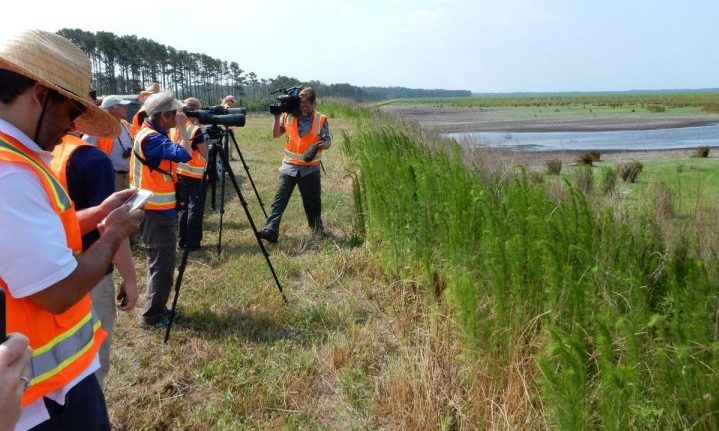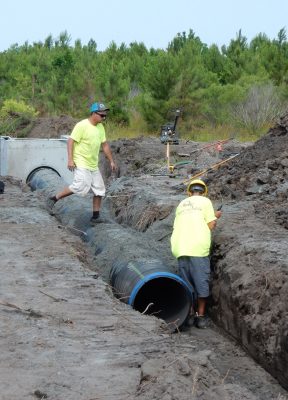
Reprinted with permission from the Carteret County News-Times
OTWAY — About 20 years of restoration work on about 6,000 acres of farmland is almost complete, and the finishing touches should be done by October at the latest.
Supporter Spotlight
This is what North Carolina Coastal Federation staff had to say Thursday while hosting a tour of the nonprofit organization’s North River Wetlands Preserve, a restoration project at the former North River Farms in Down East Carteret County.
The project began in 1999 and is the largest wetlands restoration project in North Carolina to date. During the tour, federation coastal specialist Bree Charron detailed for those in attendance the work that’s gone on over the last 20 years at the site.

“In the 1980s and 1990s this area was ditched and cleared for farming,” Charron explained. “The Coastal Federation worked with the North Carolina Clean Water Management Trust Fund to purchase the first tract, about 2,000 acres.”
In the following years, additional tracts were purchased with the help of the federation’s partner organizations, and in 2003, work began on restoring the natural wetlands that existed prior to the property being turned into farmland. The federation’s partners on the project include private hunting club 1804 Wildlife Partners LLC and the U.S. Department of Agriculture’s Natural Resources Conservation Service Wetlands Reserve Program, now called the Agricultural Conservation Easement Program.
The project was completed in 11 phases over the years. Charron said the last phase should be complete by sometime in October.
Supporter Spotlight
During the tour Thursday, the group stopped at an area being restored by contractors.
“These emergent wetlands will be grassy wetlands surrounded by forested wetlands,” Charron said. “It (the project) is under a permanent federal conservation easement, which means nothing can ever be built.”

At another stop along the tour, Coastal Wildlife Consultants contractors were installing a water control structure. Charron said these types of structures are often built to allow an area’s water level to be controlled, and the Coastal Federation intends “to hold back as much water as possible” to protect nearby waterways.
Coastal Wildlife Consultants owner Mike Johnson was also on hand at the installation site.
“My specialty is waterfowl habitat,” Johnson said. “There’s a lot of fruit to our labors. We create habitat and then manage that habitat. “
With the majority of the active restoration work complete at North River Farms, wildlife has been seen with increasing frequency. Local birder John Fussell, who was on the tour, said he’s been bird watching in the North River Farms area since late 2002.
“We’ve seen about 250 bird species here,” Fussell said. “This property includes some of North River marshes.”
Among the species seen is black rail, which has been proposed for listing under the Endangered Species Act as a threatened species.
“The endangered peregrine falcon sometimes feeds here,” Fussell said.
Other wildlife sighted at the project site include alligators, otters, beavers, bears, raccoons, snakes and terrapins.
Another reason the federation and its partners have been restoring the wetlands is to control stormwater runoff.

Stormwater is the No.1 nonpoint source of water pollution in the state. When rain events occur over areas with impervious surfaces or with poor water retention, the water flows quickly to drains and then to local water bodies. It often picks up pollutants along the way, carrying them into the water.
“When this (land) was all forested, the rain was all absorbed,” Charron said. “Once we started ditching and draining, it started running off into the adjacent waterways, caring nutrients and pathogens. One of these drainage canals can have seven million gallons of water leaving the farm a day.”
With the wetlands restored at North River Farms, the land will have better stormwater retention, filtering it instead through the ground.
“If you look at North River Farms as a whole,” Charron said, “we capture over 1 billion gallons of water per year.”









